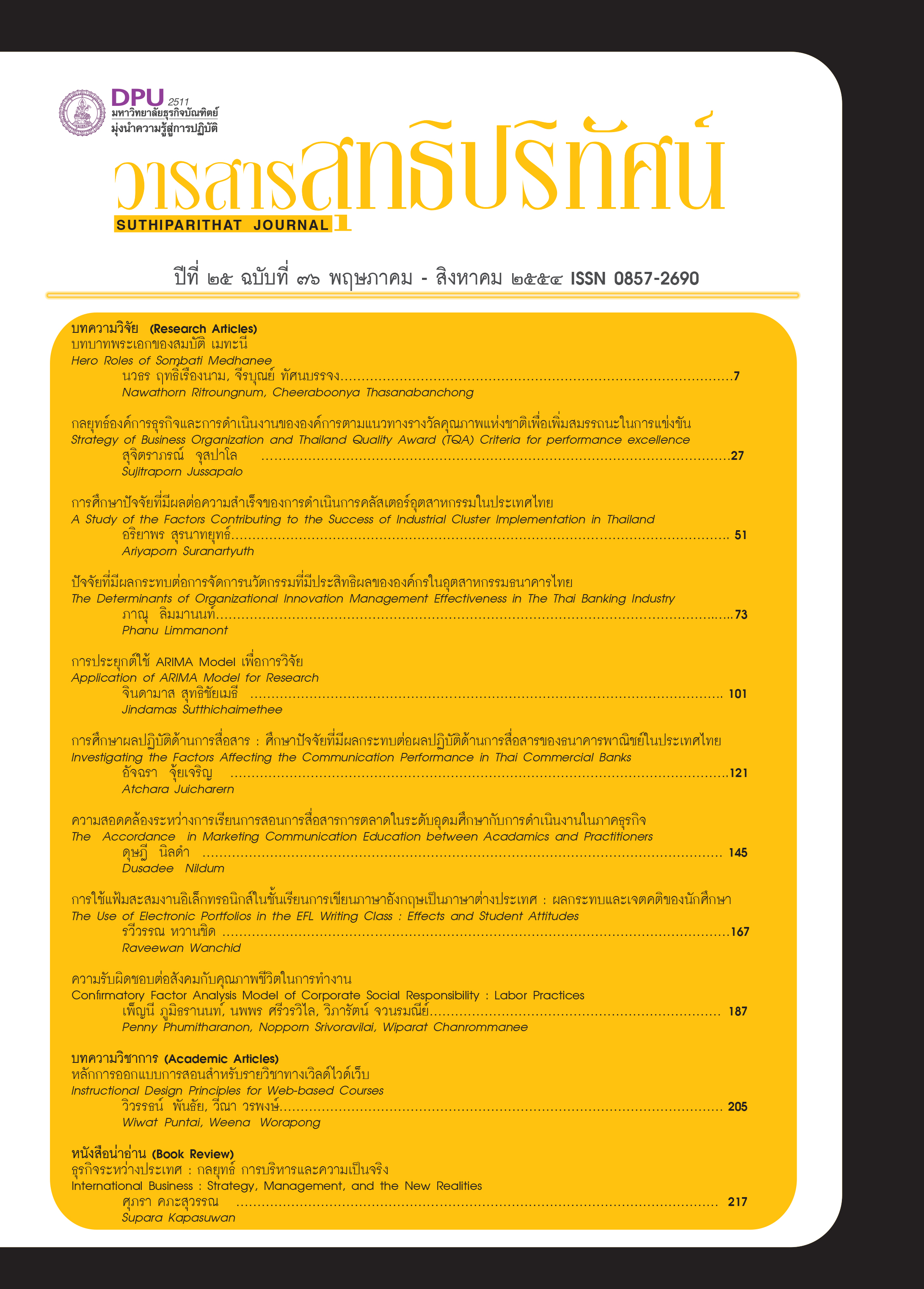กลยุทธ์องค์การธุรกิจและการดำเนินงานขององค์การตามแนวทางรางวัลคุณภาพแห่งชาติเพื่อเพิ่มสมรรถนะในการแข่งขัน
คำสำคัญ:
กลยุทธ์ธุรกิจ, รางวัลคุณภาพแห่งชาติบทคัดย่อ
บทความนี้เกี่ยวข้องกับเรื่องกลยุทธ์องค์การธุรกิจและการดำเนินงานองค์การ ตามแนวทางรางวัลคุณภาพแห่งชาติเพื่อเพิ่มสมรรถนะในการแข่งขัน โดยกล่าวถึงแนวคิด หลักการดังนี้ นิยามกลยุทธ์ธุรกิจ พัฒนาการของแนวคิดกลยุทธ์ ระดับกลยุทธ์ ขององค์การธุรกิจ กลยุทธ์ธุรกิจและกระบวนการจัดการเชิงกลยุทธ์ แนวคิดเหล่านี้เป็นแนวคิดในภาคทฤษฎี เพื่อให้กลยุทธ์องค์การธุรกิจประสบความสำเร็จในการดำเนินงานจริง ได้นำเสนอแนวคิดในภาคปฏิบัติที่มีความเชื่อมโยงระหว่างกลยุทธ์และ การดำเนินงานในหน้าที่งานต่างๆ ขององค์การคือ แนวคิดการดำเนินงานองค์การ ตามแนวทางเกณฑ์รางวัลคุณภาพแห่งชาติ ซึ่งองค์การธุรกิจควรนำแนวคิดนี้มาเป็นบรรทัดฐานสำหรับปรับปรุงวิธีการดำเนินงานหรือขีดความสามารถและรวมถึงการประเมินผลลัพธ์ขององค์การเพื่อให้องค์การมีสมรรถนะในการแข่งขัน
References
คำนาย อภิปรัชญากุล. (2549). โลจิสติกส์เพื่อการผลิตและการจัดการดำเนินงาน. (พิมพ์ครั้งที่ 2). นนทบุรี: ซี.วาย.ซิซเทิม พริ้นติ้ง.
จักร ติงศภัทิย์. (2549). กลยุทธ์: การสร้างและการนำไปปฏิบัติ. (พิมพ์ครั้งที่ 2). กรุงเทพฯ: ธรรกมลการพิมพ์.
ปกรณ์ ปรียากร. (2547). การวางแผนกลยุทธ์: แนวคิดและแนวทางเชิงประยุกต์. กรุงเทพฯ : เสมาธรรม.
พสุ เดชะรินทร์. (2551). กลยุทธ์ธุรกิจ. สืบค้นเมื่อวันที่ 4 มกราคม 2551, จาก http://www.pasuonline.net/chap7businesstrategyforpasuonline.pdf
วัฒนา วงศ์เกียรติรัตน์, กฤษณา สุวรรณภักดี, พรพรรณ ปริญญาธนกุล, วลีพร ธนาธิคม และพรทิพย์ นุกูลวุฒิโอกาศ. (2546). การวางแผนกลยุทธ์: ศิลปะการกำหนดแผนองค์การสู่ความเป็นเลิศองค์การ. กรุงเทพฯ: อินในกราฟฟริกส์.
สถาบันเพิ่มผลผลิตแห่งชาติ. (2553). TQA Criteria for Performance Excellence 2553-2554. กรุงเทพฯ: ศิวา โกลด์ มีเดีย.
Ansoff, H.I. (1965). Corporate Strategy: An Analytic Approach to Business Policy for Growth and Expansion. New Jersey: Prentice Hall.
Andrews, Kenneth. (1980). The Concept of Corporate Strategy, 2nd Edition. Dow-Jones Irwin.
Clarke, R. (1994). The Part of Development of Strategic Information System Theory. Retrieved May 20, 2007, from http://www.anu.edu.au/people/Roger.Clarke/SOS/StratISTh.html
Feurer, R. and Chaharbaghi, K. (1995). “Strategy Development: Past, Present and Future.” Management Decision, 33, 6. pp.11-21.
Hammer, M. and Champy, J. (1993). Reengineering the Corporation. London: Nicholas Brealey Publishing.
Hill, Michael A., Ireland, R. Duane and Hoskisson, Robert E. (2005). Strategic Management: Competitiveness and Globalization (Concepts and Cases). USA: Thomson South-Western.
Hubbard, Graham. (2004). Strategic Management: Thanking, Analysis & Action. Australia: Pearson Prentice Hall.
Kaplan, R. S. and Norton, D. P. (1992). “The Balanced Scorecard Measure that Drive Performance.” Harvard Business Reviwes, 1,2. pp.71-79.
Michael L.Yong. (2001). The Relationship of CIO Individual Variable of The Alignment Extent of Business Strategies and Information System Strategies. D.B.A. Florida: The University of Sarasota.
Miles, R., Snow, C., Meyer, A. D. and Coleman, H. J. (1986). “Organizational Strategy, Structure, and Process.” The Academy of Management Review, 3, 3. pp.546-562.
Mintzberg, H. (1987). “The Strategy Concept I: Five Ps For Strategy.” California Management Review, 30, 1. pp.21-30.
Mintzberg, H. and Lampel, J. (1999, Spring). “Reflecting on the Strategy Process.” Sloan Management Review. pp.21-30.
Miles, R. and Snow, C.C. (1978). Organizational Structure and Process. New York: McGraw-Hill.
_______. (1994). Fit, Failure, and the Hall of Fame: How Companies Succeed or Fail. New York: The Free Press.
Mintzberg, H. (1990). “Strategy Formation: School of Thought.” In J. Frederickson, Perspective on Strategic Management. New York: Harper Collins.
Mintzberg, H., Lampel, Joseph, Quinn, James Brian and Sumantra, Ghoshal. (2003). The Strategy Process: Concepts, Contexts, Cases. Upper Saddle River, New Jersey: Pearson Prentice Hall.
Pearce, II., John, A. and Robinson, Jr. Richard B. (2007). Strategic Management: Formulation Implementation and Control. (3th ed.). New York: McGraw-Hill.
Porter, M.E. (1980; 1985; 1998). Competitive Strategy. New York: The Free Press.
_______. (1985). Competitive Advantage: Creating and Sustaining Superior Performance. New York: The Free Press.
_______. (1985). Competitive Strategy Techniques for Analyzing Industries and Competitors. New York: The Free Press.
Prahalad, C. K. and Hamel, G. (1990, May/June). “The Core Competence of the Corporation.” Harvard Business Review. pp.79-91.
Quinn, J.B. (1980). Strategic for Change: Logical Increntalism. Homewood, III: Irwin.
Rackoff, N., Wiseman, C. and Ullrich, W. A. (1985). “Information System for Competitive Advantage: Implementation of a Planning Process.” MIS Quarterly, 9, 4. pp.285-294.
Rumelt, R. (1979). Strategic Management: A View of Business Policy and Planning (2ed,) Boston.
Schendel, D.E. and Hofer, C.W. (1979). Strategic Management: A New View of Business Policy. Boston, Massachusetts: Little Brown & Co.
Spulder, Daniel F. (2004). Management Strategy. New York: McGraw-Hill.
Wheelen, Thomas L. and Hunger, J. David. (2004). Strategic Management and Business Policy. (9th ed.). Singapore: Pearson Prentice Hall.
Wiseman, C. and Macillan, I. C. (1984). “Creating Competitive Weapons from Information Systems.” Journal of Business Strategy, 5, 2. pp.42-50.
Downloads
เผยแพร่แล้ว
How to Cite
ฉบับ
บท
License
เนื้อหาและข้อมูลในบทความที่ลงตีพิมพ์ในวารสารสุทธิปริทัศน์ ถือเป็นข้อคิดเห็นและความรับผิดชอบของผู้เขียนบทความโดยตรงซึ่งกองบรรณาธิการวารสาร ไม่จำเป็นต้องเห็นด้วย หรือร่วมรับผิดชอบใดๆ
บทความ ข้อมูล เนื้อหา รูปภาพ ฯลฯ ที่ได้รับการตีพิมพ์ในวารสารสุทธิปริทัศน์ ถือเป็นลิขสิทธิ์ของวารสารสุทธิปริทัศน์หากบุคคลหรือหน่วยงานใดต้องการนำทั้งหมดหรือส่วนหนึ่งส่วนใดไปเผยแพร่ต่อหรือเพื่อกระทำการใด ๆ จะต้องได้รับอนุญาตเป็นลายลักษณ์อักษรจากวารสารสุทธิปริทัศน์ก่อนเท่านั้น






